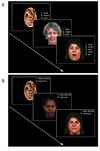Association of enhanced limbic response to threat with decreased cortical facial recognition memory response in schizophrenia
- PMID: 20194482
- PMCID: PMC4243460
- DOI: 10.1176/appi.ajp.2009.09060808
Association of enhanced limbic response to threat with decreased cortical facial recognition memory response in schizophrenia
Abstract
Objective: Recognition memory of faces is impaired in patients with schizophrenia, as is the neural processing of threat-related signals, but how these deficits interact to produce symptoms is unclear. The authors used an affective face recognition paradigm to examine possible interactions between cognitive and affective neural systems in schizophrenia.
Method: Blood-oxygen-level-dependent response was examined by means of functional magnetic resonance imaging (3 Tesla) in healthy comparison subjects (N=21) and in patients with schizophrenia (N=12) or schizoaffective disorder, depressed type (N=4), during a two-choice recognition task that used images of human faces. Each target face, previously displayed with a threatening or nonthreatening affect, was displayed with neutral affect. Responses to successful recognition and responses to the effect of previously threatening versus nonthreatening affect were evaluated, and correlations with symptom severity (total Brief Psychiatric Rating Scale score) were examined. Functional connectivity analyses examined the relationship between activation in the amygdala and cortical regions involved in recognition memory.
Results: Patients performed the task more slowly than healthy comparison subjects. Comparison subjects recruited the expected cortical regions to a greater degree than patients, and patients with more severe symptoms demonstrated proportionally less recruitment. Increased symptoms were also correlated with augmented amygdala and orbitofrontal cortex response to threatening faces. Comparison subjects exhibited a negative correlation between activity in the amygdala and cortical regions involved in cognition, while patients showed weakening of this relationship.
Conclusion: Increased symptoms were related to an enhanced threat response in limbic regions and a diminished recognition memory response in cortical regions, supporting a link between these two brain systems that are often examined in isolation. This finding suggests that abnormal processing of threat-related signals in the environment may exacerbate cognitive impairment in schizophrenia.
Figures




Comment in
-
"Splitting of the mind" revisited: recent neuroimaging evidence for functional dysconnection in schizophrenia and its relation to symptoms.Am J Psychiatry. 2010 Apr;167(4):366-8. doi: 10.1176/appi.ajp.2010.10010089. Am J Psychiatry. 2010. PMID: 20360323 Free PMC article. No abstract available.
Similar articles
-
Limbic activation associated with misidentification of fearful faces and flat affect in schizophrenia.Arch Gen Psychiatry. 2007 Dec;64(12):1356-66. doi: 10.1001/archpsyc.64.12.1356. Arch Gen Psychiatry. 2007. PMID: 18056543
-
Functional neuroimaging abnormalities in youth with psychosis spectrum symptoms.JAMA Psychiatry. 2015 May;72(5):456-65. doi: 10.1001/jamapsychiatry.2014.3169. JAMA Psychiatry. 2015. PMID: 25785510 Free PMC article.
-
Neural bases of different cognitive strategies for facial affect processing in schizophrenia.Schizophr Res. 2008 Mar;100(1-3):191-205. doi: 10.1016/j.schres.2007.11.040. Epub 2008 Jan 30. Schizophr Res. 2008. PMID: 18234477
-
Affect recognition deficits in schizophrenia: neural substrates and psychopharmacological implications.Expert Rev Neurother. 2007 Jul;7(7):807-16. doi: 10.1586/14737175.7.7.807. Expert Rev Neurother. 2007. PMID: 17610388 Review.
-
The effect of antipsychotic medication on facial affect recognition in schizophrenia: a review.Psychiatry Res. 2010 Jun 30;178(1):1-9. doi: 10.1016/j.psychres.2008.07.025. Epub 2010 May 8. Psychiatry Res. 2010. PMID: 20452051 Review.
Cited by
-
Alteration of Semantic Networks during Swear Words Processing in Schizophrenia.Clin Psychopharmacol Neurosci. 2019 Feb 28;17(1):64-73. doi: 10.9758/cpn.2019.17.1.64. Clin Psychopharmacol Neurosci. 2019. PMID: 30690941 Free PMC article.
-
Identifying Sparse Connectivity Patterns in the brain using resting-state fMRI.Neuroimage. 2015 Jan 15;105:286-99. doi: 10.1016/j.neuroimage.2014.09.058. Epub 2014 Oct 2. Neuroimage. 2015. PMID: 25284301 Free PMC article.
-
Impact of in-scanner head motion on multiple measures of functional connectivity: relevance for studies of neurodevelopment in youth.Neuroimage. 2012 Mar;60(1):623-32. doi: 10.1016/j.neuroimage.2011.12.063. Epub 2012 Jan 2. Neuroimage. 2012. PMID: 22233733 Free PMC article.
-
F-18 fluorodeoxyglucose positron emission tomography study of impaired emotion processing in first episode schizophrenia.Schizophr Res. 2015 Mar;162(1-3):103-7. doi: 10.1016/j.schres.2015.01.028. Epub 2015 Feb 2. Schizophr Res. 2015. PMID: 25655909 Free PMC article.
-
Adapting Machine Learning Diagnostic Models to New Populations Using a Small Amount of Data: Results from Clinical Neuroscience.ArXiv [Preprint]. 2024 Sep 13:arXiv:2308.03175v2. ArXiv. 2024. PMID: 39314511 Free PMC article. Preprint.
References
-
- Calkins ME, Gur RC, Ragland JD, Gur RE. Face recognition memory deficits and visual object memory performance in patients with schizophrenia and their relatives. Am J Psychiatry. 2005;162(10):1963–1966. - PubMed
-
- Kohler CG, Bilker W, Hagendoorn M, Gur RE, Gur RC. Emotion recognition deficit in schizophrenia: association with symptomatology and cognition. Biol Psychiatry. 2000;48(2):127–136. - PubMed
-
- Schneider F, Gur RC, Koch K, Backes V, Amunts K, Shah NJ, Bilker W, Gur RE, Habel U. Impairment in the specificity of emotion processing in schizophrenia. Am J Psychiatry. 2006;163(3):442–447. - PubMed
-
- Barch DM. The relationships among cognition, motivation, and emotion in schizophrenia: how much and how little we know. Schizophr Bull. 2005;31(4):875–881. - PubMed
Publication types
MeSH terms
Substances
Grants and funding
LinkOut - more resources
Full Text Sources
Medical

